Radiomics Signature Based on Support Vector Machines for the Prediction of Pathological Complete Response to Neoadjuvant Chemoradiotherapy in Locally Advanced Rectal Cancer
Abstract
:Simple Summary
Abstract
1. Introduction
2. Materials and Methods
2.1. Patients
2.2. Standard of Reference
2.3. Feature Extraction
2.4. Feature Selection and Radscore Construction
2.5. Nomogram Integrating Radscore and Clinical Indicators
2.6. Statistical Analysis
3. Results
3.1. Clinical Characteristics
3.2. Feature Selection and Radscore Construction
3.3. Nomogram Integrating Radscore and Clinical Indicators
4. Discussion
5. Conclusions
Supplementary Materials
Author Contributions
Funding
Institutional Review Board Statement
Informed Consent Statement
Data Availability Statement
Conflicts of Interest
References
- Van Gijn, W.; Marijnen, C.A.; Nagtegaal, I.D.; Kranenbarg, E.M.-K.; Putter, H.; Wiggers, T.; Rutten, H.J.; Påhlman, L.; Glimelius, B.; van de Velde, C.J.; et al. Preoperative radiotherapy combined with total mesorectal excision for resectable rectal cancer: 12-year follow-up of the multicentre, randomised controlled TME trial. Lancet Oncol. 2011, 12, 575–582. [Google Scholar] [CrossRef] [PubMed]
- Kapiteijn, E.; Marijnen, C.A.; Nagtegaal, I.D.; Putter, H.; Steup, W.H.; Wiggers, T.; Rutten, H.J.; Pahlman, L.; Glimelius, B.; Van Krieken, J.H.; et al. Preoperative radiotherapy combined with total mesorectal excision for resectable rectal cancer. N. Engl. J. Med. 2001, 345, 638–646. [Google Scholar] [CrossRef] [PubMed]
- Maas, M.; Nelemans, P.J.; Valentini, V.; Das, P.; Rödel, C.; Kuo, L.-J.; Calvo, F.A.; García-Aguilar, J.; Glynne-Jones, R.; Haustermans, K.; et al. Long-term outcome in patients with a pathological complete response after chemoradiation for rectal cancer: A pooled analysis of individual patient data. Lancet Oncol. 2010, 11, 835–844. [Google Scholar] [CrossRef]
- Renehan, A.G.; Malcomson, L.; Emsley, R.; Gollins, S.; Maw, A.; Myint, A.S.; Rooney, P.S.; Susnerwala, S.; Blower, A.; Saunders, M.P.; et al. Watch-and-wait approach versus surgical resection after chemoradiotherapy for patients with rectal cancer (the OnCoRe project): A propensity-score matched cohort analysis. Lancet Oncol. 2016, 17, 174–183. [Google Scholar] [CrossRef] [PubMed]
- Maas, M.; Beets-Tan, R.G.; Lambregts, D.M.; Lammering, G.; Nelemans, P.J.; Engelen, S.M.; van Dam, R.M.; Jansen, R.L.; Sosef, M.; Leijtens, J.W.; et al. Wait-and-see policy for clinical complete responders after chemoradiation for rectal cancer. J. Clin. Oncol. 2011, 29, 4633–4640. [Google Scholar] [CrossRef]
- Horvat, N.; Veeraraghavan, H.; Khan, M.; Blazic, I.; Zheng, J.; Capanu, M.; Sala, E.; Garcia-Aguilar, J.; Gollub, M.J.; Petkovska, I. MR imaging of rectal cancer: Radiomics analysis to assess treatment response after neoadjuvant therapy. Radiology 2018, 287, 833–843. [Google Scholar] [CrossRef]
- Van Stiphout, R.G.; Valentini, V.; Buijsen, J.; Lammering, G.; Meldolesi, E.; van Soest, J.; Leccisotti, L.; Giordano, A.; Gambacorta, M.A.; Dekker, A.; et al. Nomogram predicting response after chemoradiotherapy in rectal cancer using sequential PETCT imaging: A multicentric prospective study with external validation. Radiother. Oncol. 2014, 113, 215–222. [Google Scholar] [CrossRef]
- Li, N.; Dou, L.; Zhang, Y.; Jin, J.; Wang, G.; Xiao, Q.; Li, Y.; Wang, X.; Ren, H.; Fang, H.; et al. Use of sequential endorectal US to predict the tumor response of preoperative chemoradiotherapy in rectal cancer. Gastrointest. Endosc. 2017, 85, 669–674. [Google Scholar] [CrossRef]
- Joye, I.; Deroose, C.M.; Vandecaveye, V.; Haustermans, K. The role of diffusion-weighted MRI and (18)F-FDG PET/CT in the prediction of pathologic complete response after radiochemotherapy for rectal cancer: A systematic review. Radiother. Oncol. 2014, 113, 158–165. [Google Scholar] [CrossRef]
- Shin, J.; Seo, N.; Baek, S.-E.; Son, N.-H.; Lim, J.S.; Kim, N.K.; Koom, W.S.; Kim, S. MRI radiomics model predicts pathologic complete response of rectal cancer following chemoradiotherapy. Radiology 2022, 303, 351–358. [Google Scholar] [CrossRef]
- Giannini, V.; Mazzetti, S.; Bertotto, I.; Chiarenza, C.; Cauda, S.; Delmastro, E.; Bracco, C.; Di Dia, A.; Leone, F.; Medico, E.; et al. Predicting locally advanced rectal cancer response to neoadjuvant therapy with 18F-FDG PET and MRI radiomics features. Eur. J. Nucl. Med. Mol. Imaging 2019, 46, 878–888. [Google Scholar] [CrossRef] [PubMed]
- Yuan, Z.; Frazer, M.; Zhang, G.G.; Latifi, K.; Moros, E.G.; Feygelman, V.; Felder, S.; Sanchez, J.; Dessureault, S.; Imanirad, I.; et al. CT-based radiomic features to predict pathological response in rectal cancer: A retrospective cohort study. J. Med. Imaging Radiat. Oncol. 2020, 64, 444–449. [Google Scholar] [CrossRef] [PubMed]
- Lutsyk, M.; Gourevich, K.; Keidar, Z. Complete pathologic response prediction by radiomics wavelets features of unenhanced CT simulation images in locally advanced rectal cancer patients after neoadjuvant chemoradiation. Isr. Med. Assoc. J. 2021, 23, 805–810. [Google Scholar] [CrossRef] [PubMed]
- Bonomo, P.; Fernandez, J.S.; Thorwarth, D.; Casati, M.; Livi, L.; Zips, D.; Gani, C. Simulation CT-based radiomics for prediction of response after neoadjuvant chemo-radiotherapy in patients with locally advanced rectal cancer. Radiat. Oncol. 2022, 17, 84. [Google Scholar] [CrossRef]
- Bibault, J.E.; Giraud, P.; Housset, M.; Durdux, C.; Taieb, J.; Berger, A.; Coriat, R.; Chaussade, S.; Dousset, B.; Nordlinger, B. Deep learning and radiomics predict complete response after neo-adjuvant chemoradiation for locally advanced rectal cancer. Sci. Rep. 2018, 8, 12611. [Google Scholar] [CrossRef]
- Zhuang, Z.; Liu, Z.; Li, J.; Wang, X.; Xie, P.; Xiong, F.; Hu, J.; Meng, X.; Huang, M.; Deng, Y.; et al. Radiomic signature of the FOWARC trial predicts pathological response to neoadjuvant treatment in rectal cancer. J. Transl. Med. 2021, 19, 256. [Google Scholar] [CrossRef] [PubMed]
- Wang, D.; Lee, S.H.; Geng, H.; Zhong, H.; Plastaras, J.; Wojcieszynski, A.; Caruana, R.; Xiao, Y. Interpretable machine learning for predicting pathologic complete response in patients treated with chemoradiation therapy for rectal adenocarcinoma. Front. Artif. Intell. 2022, 5, 1059033. [Google Scholar] [CrossRef]
- Mao, Y.; Pei, Q.; Fu, Y.; Liu, H.; Chen, C.; Li, H.; Gong, G.; Yin, H.; Pang, P.; Lin, H.; et al. Pre-treatment computed tomography radiomics for predicting the response to neoadjuvant chemoradiation in locally advanced rectal cancer: A retrospective study. Front. Oncol. 2022, 12, 850774. [Google Scholar] [CrossRef]
- Zhang, Z.; Yi, X.; Pei, Q.; Fu, Y.; Li, B.; Liu, H.; Han, Z.; Chen, C.; Pang, P.; Lin, H.; et al. CT radiomics identifying non-responders to neoadjuvant chemoradiotherapy among patients with locally advanced rectal cancer. Cancer Med. 2023, 12, 2463–2473. [Google Scholar] [CrossRef]
- Vandendorpe, B.; Durot, C.; Lebellec, L.; Le Deley, M.-C.; Sylla, D.; Bimbai, A.-M.; Amroun, K.; Ramiandrisoa, F.; Cordoba, A.; Mirabel, X.; et al. Prognostic value of the texture analysis parameters of the initial computed tomographic scan for response to neoadjuvant chemoradiation therapy in patients with locally advanced rectal cancer. Radiother. Oncol. 2019, 135, 153–160. [Google Scholar] [CrossRef]
- Cui, Y.; Yang, X.; Shi, Z.; Yang, Z.; Du, X.; Zhao, Z.; Cheng, X. Radiomics analysis of multiparametric MRI for prediction of pathological complete response to neoadjuvant chemoradiotherapy in locally advanced rectal cancer. Eur. Radiol. 2019, 29, 1211–1220. [Google Scholar] [CrossRef] [PubMed]
- Zhang, S.; Tang, B.; Yu, M.; He, L.; Zheng, P.; Yan, C.; Li, J.; Peng, Q. Development and validation of a radiomics model based on lymph-node regression grading after neoadjuvant chemoradiotherapy in locally advanced rectal cancer. Int. J. Radiat. Oncol. Biol. Phys. 2023, 117, 821–833. [Google Scholar] [CrossRef] [PubMed]
- Chen, H.-Z.; Wang, X.-R.; Zhao, F.-M.; Chen, X.-J.; Li, X.-S.; Ning, G.; Guo, Y.-K. The development and validation of a CT-based radiomics nomogram to preoperatively predict lymph node metastasis in high-grade serous ovarian cancer. Front. Oncol. 2021, 11, 711648. [Google Scholar] [CrossRef] [PubMed]
- Yang, X.; Dong, X.; Wang, J.; Li, W.; Gu, Z.; Gao, D.; Zhong, N.; Guan, Y. Computed Tomography-Based Radiomics Signature: A Potential Indicator of Epidermal Growth Factor Receptor Mutation in Pulmonary Adenocarcinoma Appearing as a Subsolid Nodule. Oncologist 2019, 24, e1156–e1164. [Google Scholar] [CrossRef] [PubMed]
- Ye, C.; Ren, S.; Sadula, A.; Guo, X.; Yuan, M.; Meng, M.; Li, G.; Zhang, X.; Yuan, C. The expression characteristics of transmembrane protein genes in pancreatic ductal adenocarcinoma through comprehensive analysis of bulk and single-cell RNA sequence. Front. Oncol. 2023, 13, 1047377. [Google Scholar] [CrossRef]
- Ishwaran, H.; Lu, M. Standard errors and confidence intervals for variable importance in random forest regression, classification, and survival. Stat. Med. 2019, 38, 558–582. [Google Scholar] [CrossRef]
- Chen, H.-Z.; Wang, X.-R.; Zhao, F.-M.; Chen, X.-J.; Li, X.-S.; Ning, G.; Guo, Y.-K. A CT-based radiomics nomogram for predicting early recurrence in patients with high-grade serous ovarian cancer. Eur. J. Radiol. 2021, 145, 110018. [Google Scholar] [CrossRef]
- Liu, Z.; Li, M.; Zuo, C.; Yang, Z.; Yang, X.; Ren, S.; Peng, Y.; Sun, G.; Shen, J.; Cheng, C.; et al. Radiomics model of dual-time 2-[18F]FDG PET/CT imaging to distinguish between pancreatic ductal adenocarcinoma and autoimmune pancreatitis. Eur. Radiol. 2021, 31, 6983–6991. [Google Scholar] [CrossRef]
- Gu, D.; Xie, Y.; Wei, J.; Li, W.; Ye, Z.; Zhu, Z.; Tian, J.; Li, X. MRI-Based Radiomics Signature: A Potential Biomarker for Identifying Glypican 3-Positive Hepatocellular Carcinoma. J. Magn. Reson. Imaging 2020, 52, 1679–1687. [Google Scholar] [CrossRef]
- Duan, K.-B.; Rajapakse, J.; Wang, H.; Azuaje, F. Multiple SVM-RFE for gene selection in cancer classification with expression data. IEEE Trans. Nanobiosci. 2005, 4, 228–234. [Google Scholar] [CrossRef]
- Chen, B.-Y.; Xie, H.; Li, Y.; Jiang, X.-H.; Xiong, L.; Tang, X.-F.; Lin, X.-F.; Li, L.; Cai, P.-Q. MRI-based radiomics features to predict treatment response to neoadjuvant chemotherapy in locally advanced rectal cancer: A single center, prospective study. Front. Oncol. 2022, 12, 801743. [Google Scholar] [CrossRef] [PubMed]
- Sun, S.; Ren, L.; Miao, Z.; Hua, L.; Wang, D.; Deng, J.; Chen, J.; Liu, N.; Gong, Y. Application of MRI-Based Radiomics in Preoperative Prediction of NF2 Alteration in Intracranial Meningiomas. Front. Oncol. 2022, 12, 879528. [Google Scholar] [CrossRef]
- Luo, Y.; Chen, H.; Cui, M. Radiomics and Hybrid Models Based on Machine Learning to Predict Levodopa-Induced Dyskinesia of Parkinson’s Disease in the First 6 Years of Levodopa Treatment. Diagnostics 2023, 13, 2511. [Google Scholar] [CrossRef] [PubMed]
- Xiang, Y.; Li, S.; Wang, H.; Song, M.; Hu, K.; Wang, F.; Wang, Z.; Niu, Z.; Liu, J.; Cai, Y.; et al. MRI-based radiomics to predict neoadjuvant chemoradiotherapy outcomes in locally advanced rectal cancer: A multicenter study. Clin. Transl. Radiat. Oncol. 2022, 38, 175–182. [Google Scholar] [CrossRef]
- Deng, Z.; Dong, W.; Xiong, S.; Jin, D.; Zhou, H.; Zhang, L.; Xie, L.; Deng, Y.; Xu, R.; Fan, B. Machine learning models combining computed tomography semantic features and selected clinical variables for accurate prediction of the pathological grade of bladder cancer. Front. Oncol. 2023, 13, 1166245. [Google Scholar] [CrossRef]
- Meng, X.; Xia, W.; Xie, P.; Zhang, R.; Li, W.; Wang, M.; Xiong, F.; Liu, Y.; Fan, X.; Xie, Y.; et al. Preoperative radiomic signature based on multiparametric magnetic resonance imaging for noninvasive evaluation of biological characteristics in rectal cancer. Eur. Radiol. 2019, 29, 3200–3209. [Google Scholar] [CrossRef] [PubMed]
- Gao, X.; Cui, J.; Wang, L.; Wang, Q.; Ma, T.; Yang, J.; Ye, Z. The value of machine learning based radiomics model in preoperative detection of perineural invasion in gastric cancer: A two-center study. Front. Oncol. 2023, 13, 1205163. [Google Scholar] [CrossRef] [PubMed]
- Wang, Q.; Chen, Y.; Qin, S.; Liu, X.; Liu, K.; Xin, P.; Zhao, W.; Yuan, H.; Lang, N. Prognostic Value and Quantitative CT Analysis in RANKL Expression of Spinal GCTB in the Denosumab Era: A Machine Learning Approach. Cancers 2022, 14, 5201. [Google Scholar] [CrossRef]
- Shi, Z.-X.; Li, C.-F.; Zhao, L.-F.; Sun, Z.-Q.; Cui, L.-M.; Xin, Y.-J.; Wang, D.-Q.; Kang, T.-R.; Jiang, H.-J. Computed tomography radiomic features and clinical factors predicting the response to first transarterial chemoembolization in intermediate-stage hepatocellular carcinoma. Hepatobiliary Pancreat. Dis. Int. 2023, in press. [Google Scholar] [CrossRef]
- Cortes, C.; Vapnik, V. Support vector networks. Mach. Learn. 1995, 20, 273–297. [Google Scholar] [CrossRef]
- Schölkopf, B.; Platt, J.C.; Shawe-Taylor, J.; Smola, A.J.; Williamson, R.C. Estimating the support of a high-dimensional distribution. Neural Comput. 2001, 13, 1443–1471. [Google Scholar] [CrossRef] [PubMed]
- Cervantes, J.; Garcia-Lamont, F.; Rodríguez-Mazahua, L.; Lopez, A. A comprehensive survey on support vector machine classification: Applications, challenges and trends. Neurocomputing 2020, 408, 189–215. [Google Scholar] [CrossRef]
- Ranzato, F.; Zanella, M. Robustness verification of support vector machines. In Static Analysis, Proceedings of the 26th International Symposium, SAS 2019, Porto, Portugal, 8–11 October 2019; Springer: Berlin/Heidelberg, Germany, 2019; p. 11822. [Google Scholar]
- Hamerla, G.; Meyer, H.J.; Hambsch, P.; Wolf, U.; Kuhnt, T.; Hoffmann, K.T.; Surov, A. Radiomics model based on non-contrast CT shows no predictive power for complete pathological response in locally advanced rectal cancer. Cancers 2019, 11, 1680. [Google Scholar] [CrossRef] [PubMed]
- Nardone, V.; Reginelli, A.; Grassi, R.; Boldrini, L.; Vacca, G.; D’ippolito, E.; Annunziata, S.; Farchione, A.; Belfiore, M.P.; Desideri, I.; et al. Delta radiomics: A systematic review. Radiol. Med. 2021, 126, 1571–1583. [Google Scholar] [CrossRef] [PubMed]
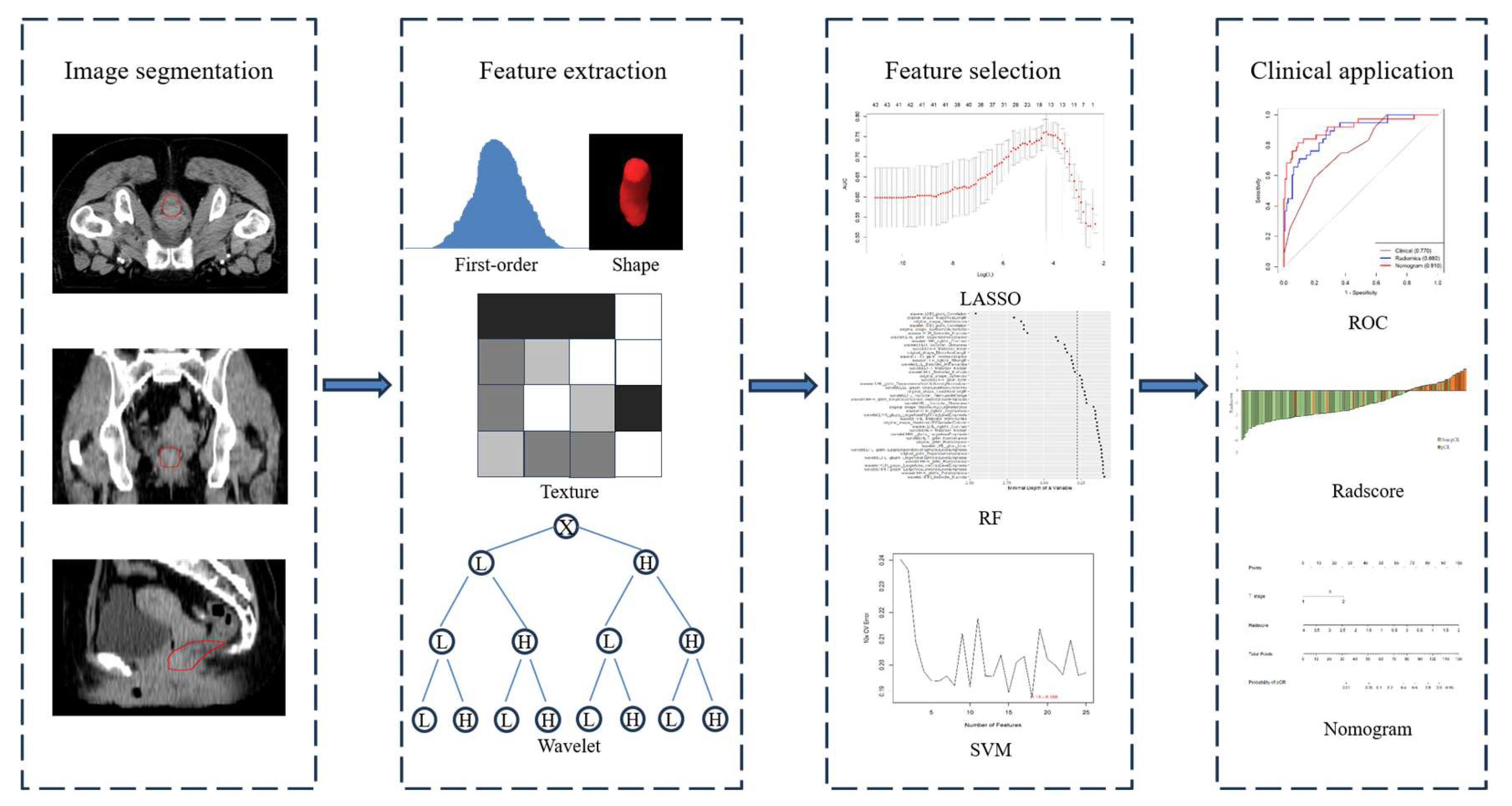
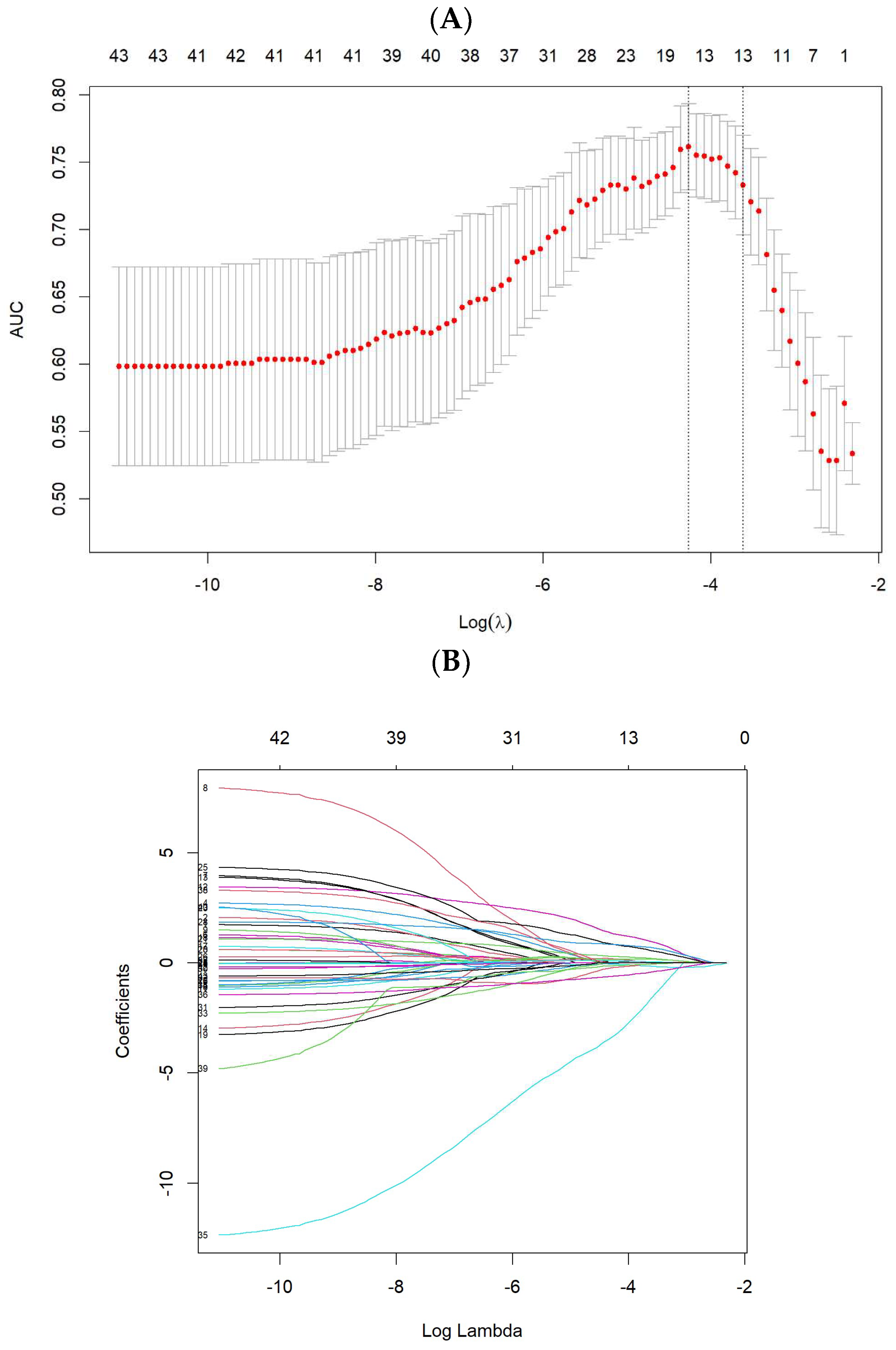
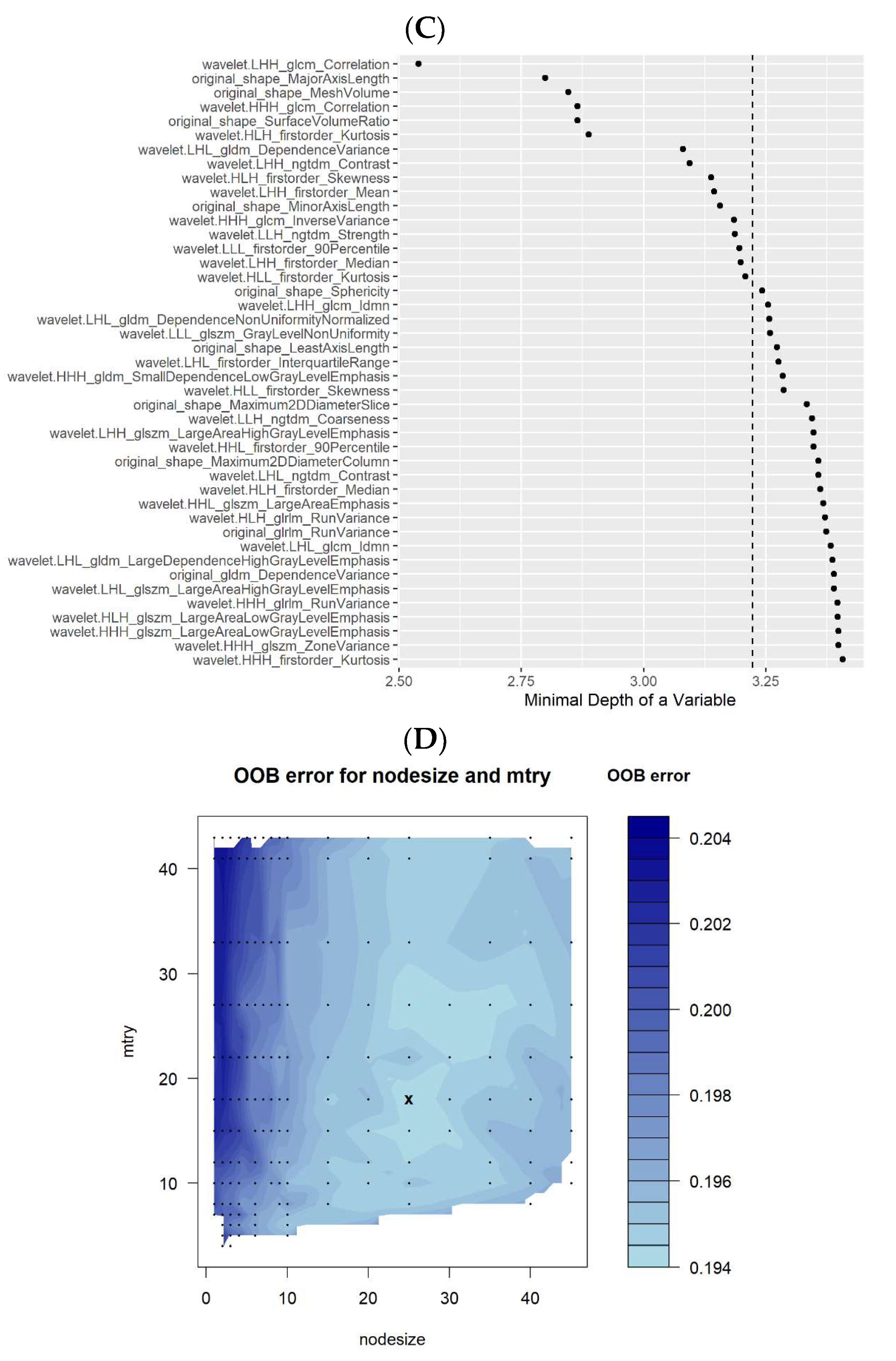
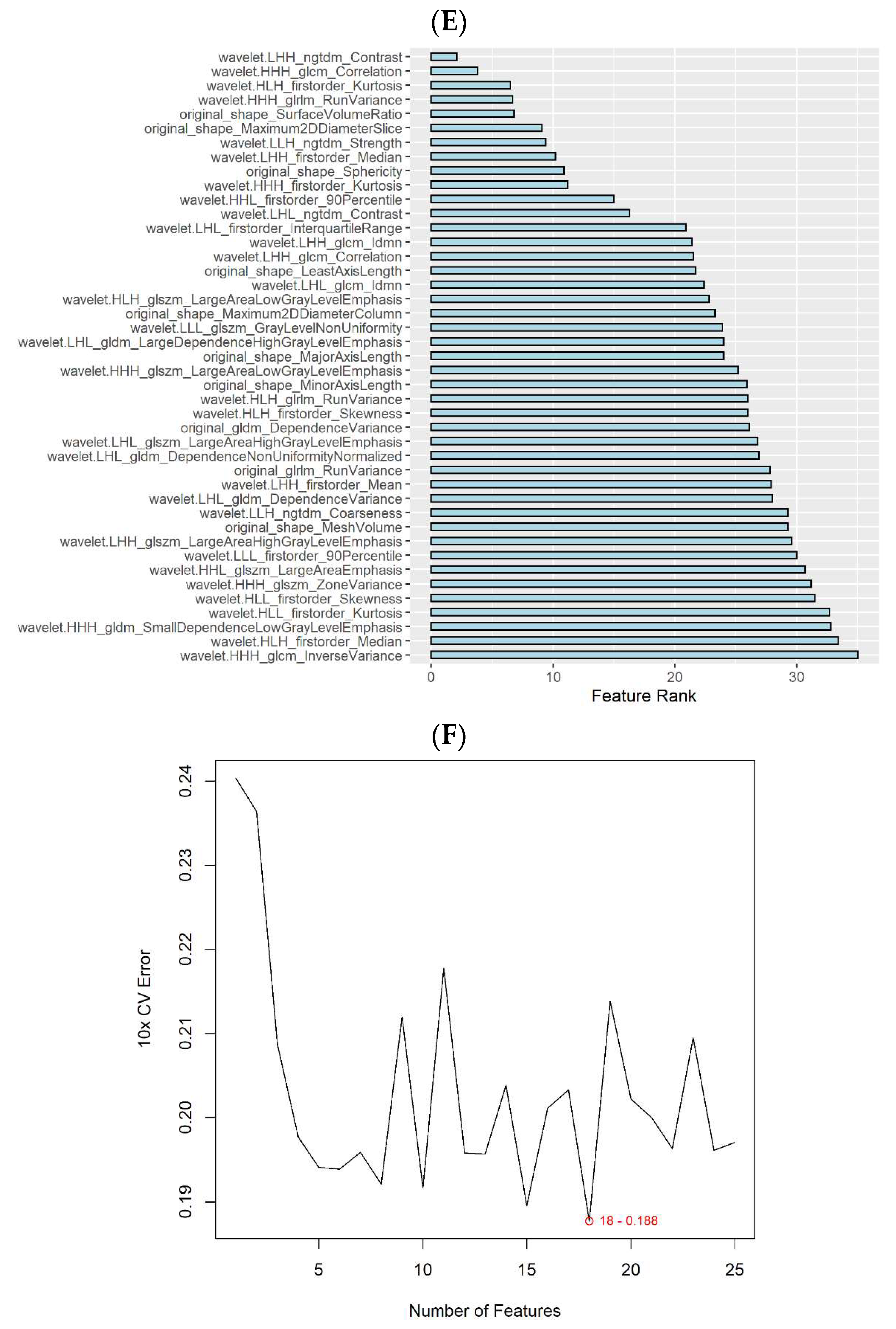

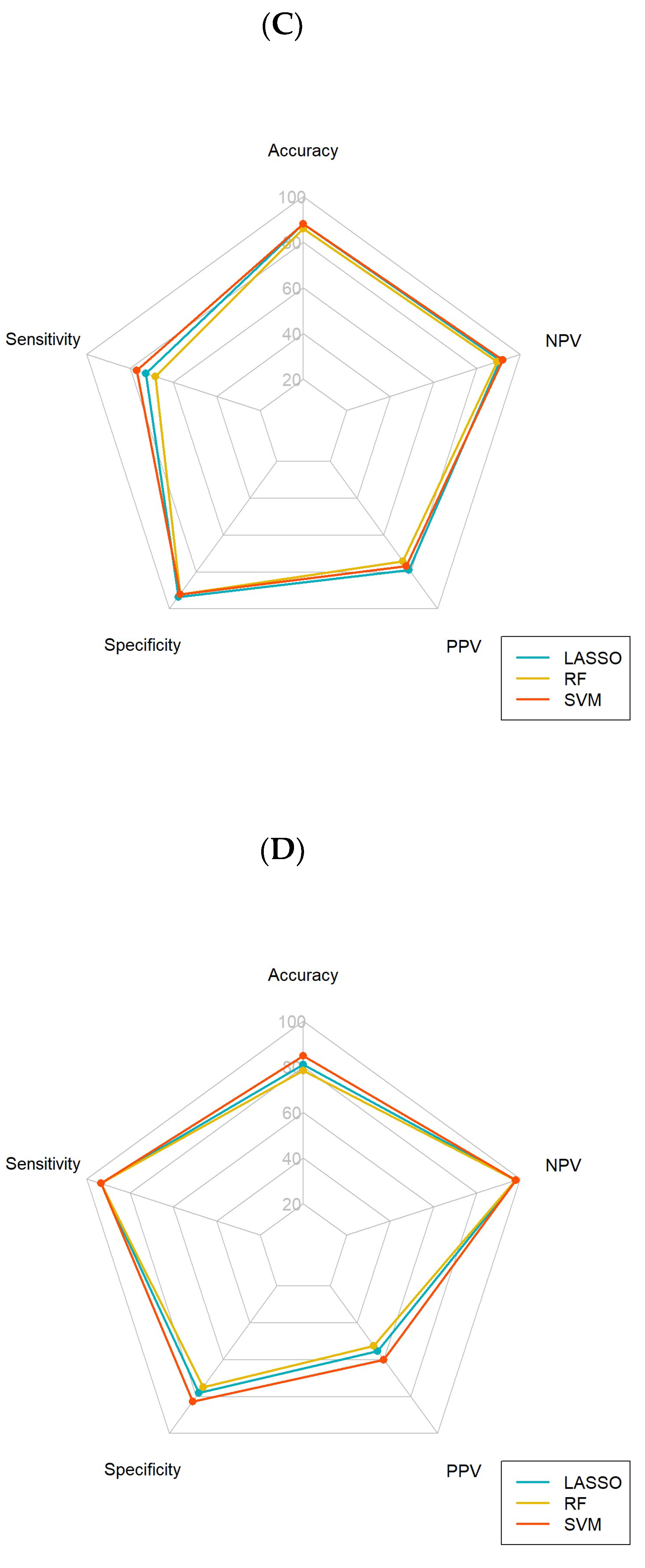
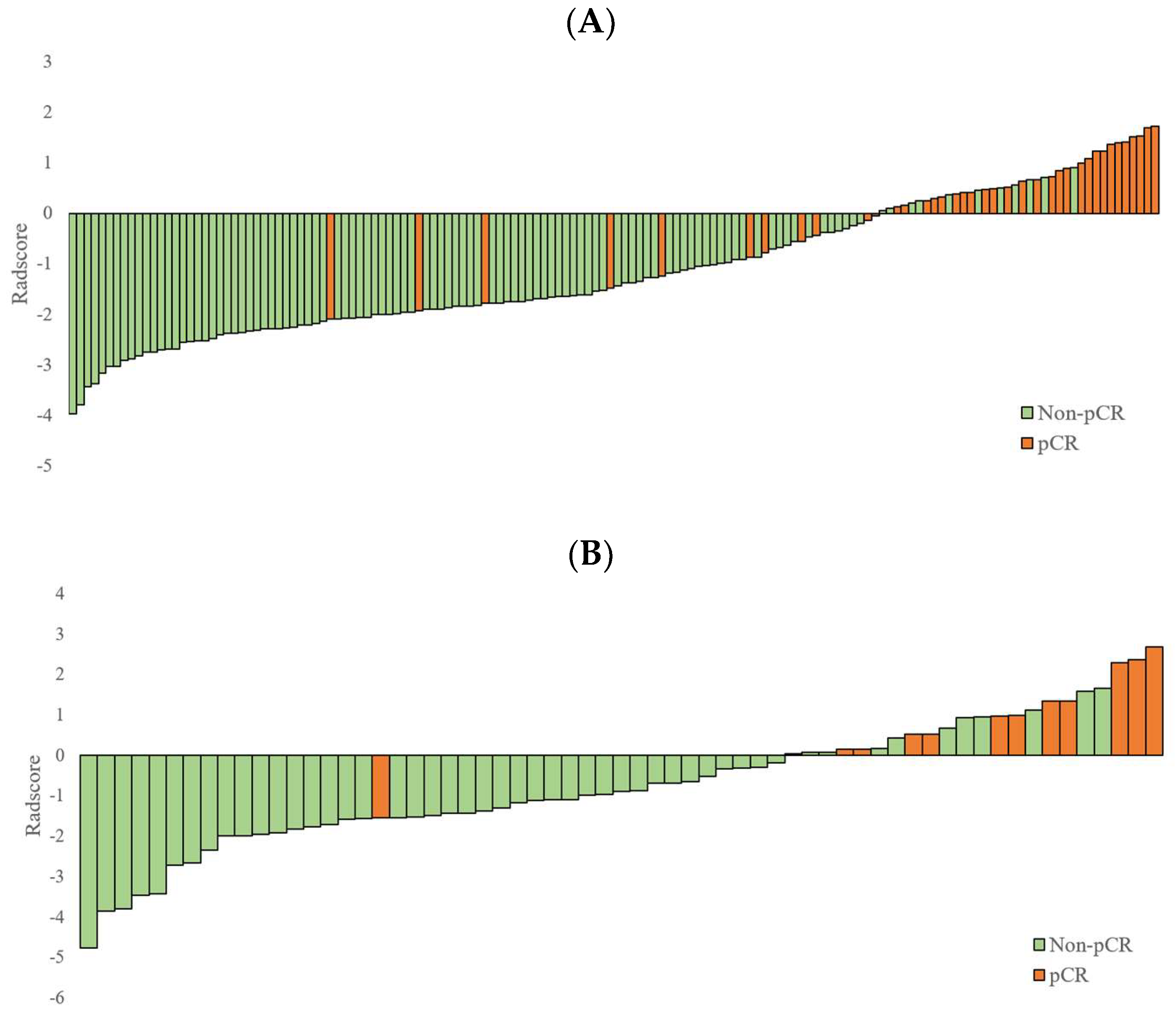

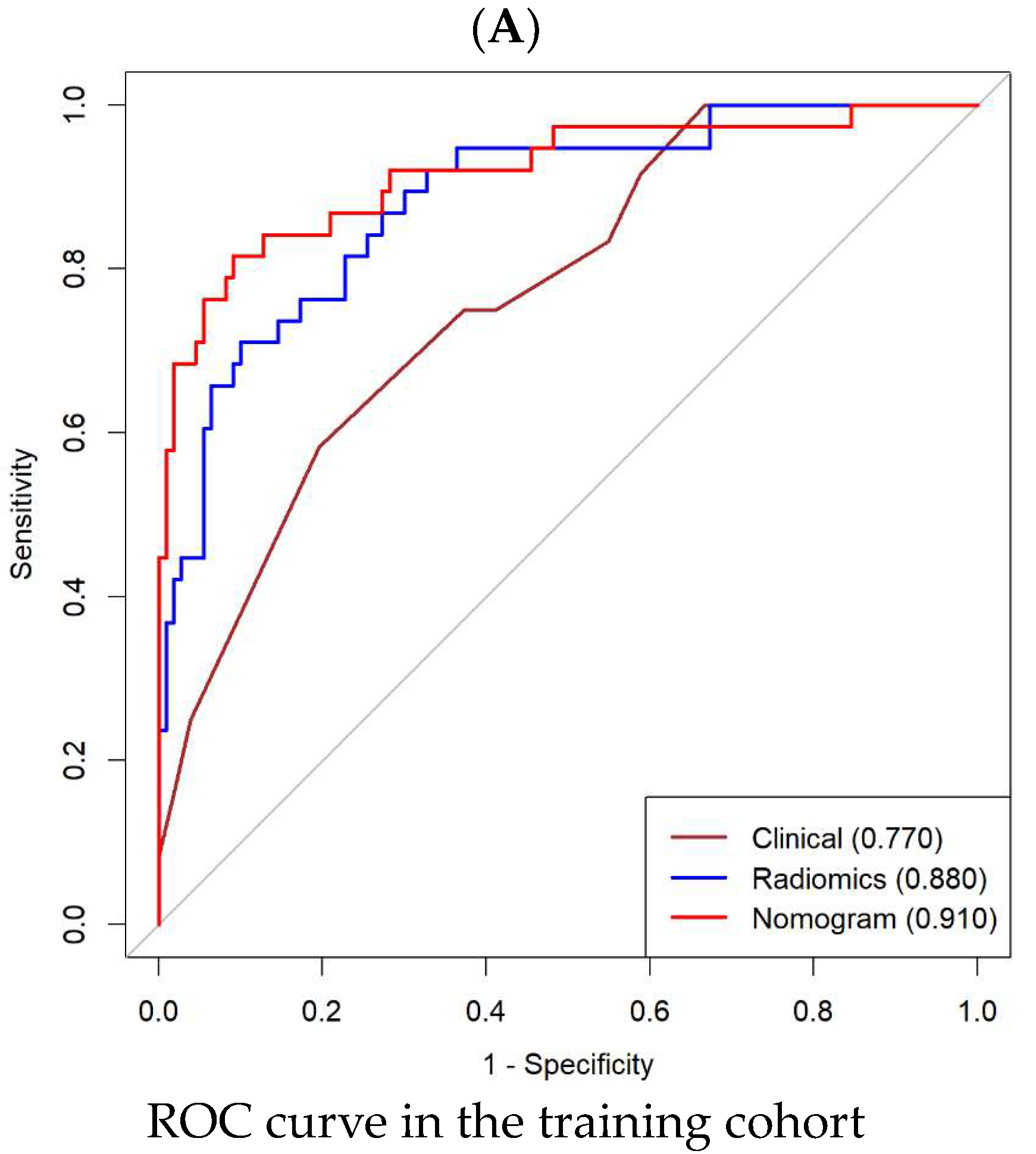


| Training Cohort | Validation Cohort | |||||
|---|---|---|---|---|---|---|
| Characteristics | Non-pCR | pCR | p Value | Non-pCR | pCR | p Value |
| Gender | 0.819 | 0.960 | ||||
| Male | 74 (67.3%) | 27 (71.1%) | 37 (72.5%) | 8 (66.7%) | ||
| Female | 36 (22.7%) | 11 (28.9%) | 14 (27.5%) | 4 (33.3%) | ||
| Age | 0.341 | 0.052 | ||||
| >60 | 49 (44.5%) | 21 (55.3%) | 27 (52.9%) | 2 (16.7%) | ||
| ≤60 | 61 (55.5%) | 17 (44.7%) | 24 (47.1%) | 10 (83.3%) | ||
| BMI | 0.056 | 0.687 | ||||
| >21.7 | 66 (60.0%) | 30 (78.9%) | 37 (72.5%) | 10 (83.3%) | ||
| ≤21.7 | 44 (40.0%) | 8 (21.1%) | 14 (27.5%) | 2 (16.7%) | ||
| Tumor volume | 110 | 38 | 0.005 * | 51 | 12 | 0.914 |
| >51.7 cm3 | 63 (57.3%) | 11 (28.9%) | 29 (56.9%) | 6 (50.0%) | ||
| ≤51.7 cm3 | 47 (42.7%) | 27 (71.1%) | 22 (43.1%) | 6 (50.0%) | ||
| Tumor diameter | 0.061 | 0.237 | ||||
| >4.7 cm | 53 (48.2%) | 11 (28.9%) | 25 (49.0%) | 3 (25.0%) | ||
| ≤4.7 cm | 57 (51.8%) | 27 (71.1%) | 26 (51.0%) | 9 (75.0%) | ||
| Tumor length | 0.093 | 0.934 | ||||
| >4.7 cm | 79 (71.8%) | 21 (55.3%) | 35 (31.4%) | 9 (75.0%) | ||
| ≤4.7 cm | 31 (28.2%) | 17 (44.7%) | 16 (68.6%) | 3 (25.0%) | ||
| Distance from anal verge | 0.356 | 0.898 | ||||
| >4.0 cm | 86 (78.2%) | 33 (86.8%) | 39 (76.5%) | 10 (83.3%) | ||
| ≤4.0 cm | 24 (21.8%) | 5 (13.2%) | 12 (23.5%) | 2 (16.7%) | ||
| T stage | 0.951 | 0.225 | ||||
| 2 | 4 (3.4%) | 1 (3.2%) | 2 (3.9%) | 0 (0.0%) | ||
| 3 | 59 (54.0%) | 21 (61.9%) | 29 (56.9%) | 10 (83.3%) | ||
| 4 | 47 (42.6%) | 16 (34.9%) | 20 (39.2%) | 2 (16.7%) | ||
| N stage | 0.650 | 0.627 | ||||
| 0 | 9 (8.2%) | 3 (7.9%) | 8 (25.7%) | 1 (8.3%) | ||
| 1 | 33 (30.0%) | 12 (31.6%) | 12 (23.5%) | 5 (41.7%) | ||
| 2 | 37 (33.6%) | 16 (42.1%) | 26 (51.0%) | 5 (41.7%) | ||
| 3 | 31 (28.2%) | 7 (18.4%) | 5 (9.8%) | 1 (8.3%) | ||
| CEA | 1 | 0.237 | ||||
| >5 ng/mL | 49 (44.5%) | 17 (44.7%) | 25 (49.0%) | 3 (25.0%) | ||
| ≤5 ng/mL | 61 (55.5%) | 21 (55.3%) | 26 (51.0%) | 9 (75.0%) | ||
| CA19-9 | 0.453 | 1 | ||||
| >37 U/mL | 13 (11.8%) | 7 (7.9%) | 6 (11.8%) | 1 (8.3%) | ||
| ≤37 U/mL | 97 (88.2%) | 31 (92.1%) | 45 (88.2%) | 11 (91.7%) | ||
| Prescription dose | 1 | 0.171 | ||||
| 57.5 Gy | 80 (72.7%) | 27 (71.1%) | 29 (56.9%) | 10 (83.3%) | ||
| 50 Gy | 30 (27.3%) | 11 (28.9%) | 22 (43.1%) | 2 (16.7%) | ||
| Radscore (mean ± SD) | −1.6742 ± 0.8722 | −0.2601 ± 1.1362 | 0.000 * | −1.6379 ± 0.9098 | −0.3133 ± 1.0479 | 0.000 * |
| Univariate Analysis | Multivariate Analysis | |||||
|---|---|---|---|---|---|---|
| Features | β | OR (95% CI) | p Value | β | OR (95% CI) | p Value |
| Gender | 0.177 | 1.194 (0.543–2.757) | 0.666 | |||
| Age | 0.430 | 1.538 (0.734–3.261) | 0.255 | |||
| BMI | 0.916 | 2.500 (1.090–6.307) | 0.039 * | |||
| Tumor volume | −1.191 | 0.304 (0.133–0.659) | 0.003 * | |||
| Tumor diameter | −0.825 | 0.438 (0.191–0.949) | 0.042 * | |||
| Tumor length | −0.724 | 0.485 (0.226–1.045) | 0.063 | |||
| Distance from anal verge | 0.611 | 1.842 (0.694–5.825) | 0.251 | |||
| T stage | −1.013 | 0.363 (0.137–0.595) | 0.035 * | −1.167 | 0.311 (0.104–0.841) | 0.027 * |
| N stage | −0.128 | 0.880 (0.588–1.317) | 0.533 | |||
| CEA | 0.008 | 1.008 (0.476–2.114) | 0.984 | |||
| CA19-9 | 0.522 | 1.685 (0.588–4.505) | 0.308 | |||
| Prescription dose | −0.011 | 0.989 (0.889–1.107) | 0.842 | |||
| Radscore | 1.451 | 4.266 (2.658–7.470) | 0.000 * | 1.651 | 5.212 (2.993–10.161) | 0.000 * |
| Clinical | Radiomics | Nomogram | ||||
|---|---|---|---|---|---|---|
| Metrics | Training (95% CI) | Validation (95% CI) | Training (95% CI) | Validation (95% CI) | Training (95%CI) | Validation (95% CI) |
| AUC | 0.770 (0.629–0.911) | 0.725 (0.642–0.808) | 0.880 (0.823–0.946) | 0.830 (0.722–0.928) | 0.910 (0.815–0.976) | 0.866 (0.762–0.970) |
| Accuracy | 0.750 (0.676–0.764) | 0.683 (0.540–0.857) | 0.851 (0.703–0.912) | 0.810 (0.667–0.873) | 0.885 (0.797–0.946) | 0.841 (0.651–0.937) |
| Sensitivity | 0.605 (0.553–0.842) | 0.750 (0.500–1) | 0.711 (0.632–1) | 0.917 (0.750–1) | 0.816 (0.684–0.947) | 0.917 (0.667–1) |
| Specificity | 0.800 (0.554–0.918) | 0.667 (0.471–0.902) | 0.900 (0.627–0.964) | 0.784 (0.588–0.882) | 0.909 (0.763–0.991) | 0.824 (0.588–0.961) |
| PPV | 0.511 (0.343–0.786) | 0.346 (0.250–0.611) | 0.711 (0.462–0.879) | 0.500 (0.344–0.611) | 0.756 (0.581–0.968) | 0.550 (0.333–0.833) |
| NPV | 0.854 (0.815–0.926) | 0.919 (0.857–0.975) | 0.900 (0.880–0.989) | 0.976 (0.921–1) | 0.935 (0.897–0.980) | 0.977 (0.907–1) |
| MCC | 0.385 (0.094–0.742) | 0.332 (0.023–0.798) | 0.611 (0.228–0.934) | 0.577 (0.266–0.766) | 0.708 (0.409–0.947) | 0.624 (0.201–0.908) |
| F1 score | 0.554 (0.423–0.813) | 0.474 (0.333–0.759) | 0.711 (0.534–0.936) | 0.647 (0.472–0.759) | 0.785 (0.628–0.957) | 0.688 (0.444–0.909) |
Disclaimer/Publisher’s Note: The statements, opinions and data contained in all publications are solely those of the individual author(s) and contributor(s) and not of MDPI and/or the editor(s). MDPI and/or the editor(s) disclaim responsibility for any injury to people or property resulting from any ideas, methods, instructions or products referred to in the content. |
© 2023 by the authors. Licensee MDPI, Basel, Switzerland. This article is an open access article distributed under the terms and conditions of the Creative Commons Attribution (CC BY) license (https://creativecommons.org/licenses/by/4.0/).
Share and Cite
Li, C.; Chen, H.; Zhang, B.; Fang, Y.; Sun, W.; Wu, D.; Su, Z.; Shen, L.; Wei, Q. Radiomics Signature Based on Support Vector Machines for the Prediction of Pathological Complete Response to Neoadjuvant Chemoradiotherapy in Locally Advanced Rectal Cancer. Cancers 2023, 15, 5134. https://doi.org/10.3390/cancers15215134
Li C, Chen H, Zhang B, Fang Y, Sun W, Wu D, Su Z, Shen L, Wei Q. Radiomics Signature Based on Support Vector Machines for the Prediction of Pathological Complete Response to Neoadjuvant Chemoradiotherapy in Locally Advanced Rectal Cancer. Cancers. 2023; 15(21):5134. https://doi.org/10.3390/cancers15215134
Chicago/Turabian StyleLi, Chao, Haiyan Chen, Bicheng Zhang, Yimin Fang, Wenzheng Sun, Dang Wu, Zhuo Su, Li Shen, and Qichun Wei. 2023. "Radiomics Signature Based on Support Vector Machines for the Prediction of Pathological Complete Response to Neoadjuvant Chemoradiotherapy in Locally Advanced Rectal Cancer" Cancers 15, no. 21: 5134. https://doi.org/10.3390/cancers15215134





